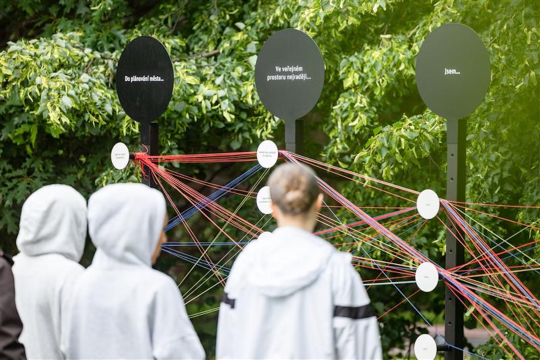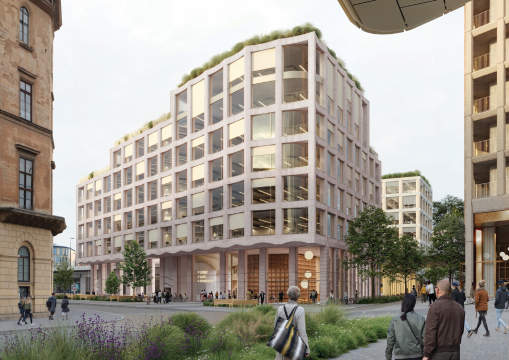The new Štvanická Footbridge has been opened to the public, finally connecting Karlín, Štvanice and Holešovice.
The Štvanická Footbridge, also referred to as the HolKa Footbridge because it connects the neighborhoods of Holesovice and Karlin, was officially opened on July 28th, 2023. The footbridge, which is intended only for pedestrians and cyclists, also connects the two neighborhoods with the island of Štvanice. IPR Prague organized an architectural competition in 2017, and construction of the footbridge began in early 2022. The project was in many ways a pilot and succeeded thanks to exemplary cooperation between the city and the relevant city districts.

Zdeněk Hřib, Prague’s Deputy Mayor for Transport, says: "The ferry that used to connect the two banks of the Vltava River has been replaced by an elegant white footbridge. The clean shapes of the footbridge have been enriched with remarkable details, such as illuminated bronze railings that terminate in artistic renditions of animals. While the footbridge will serve mainly pedestrians and cyclists, it was built to allow for emergency vehicles. Prototypes of the new urban navigation system, ‘Readable Prague,’ which will serve for better orientation around the city, are also included."
Petr Hlaváček, Prague's Deputy Mayor for Urban and Strategic Planning, notes: "The footbridge not only connects Holešovice and Karlín, but also makes the island of Štvanice accessible. Our long-term vision is for Štvanice to be a landscaped recreational zone where the people of Prague can come to spend their free time, play sports, or visit cultural attractions. We have planned the changes in stages and with possible variations according to the agreements made with local stakeholders."
The footbridge is now a simple link for pedestrians and cyclists between the city districts of Prague 7 and Prague 8, while providing direct access to Štvanice Island. The three-hundred-meter-long structure made of white, ultra-high-quality concrete with an anti-graffiti coating is unusual in its curvature. The bridge is illuminated by LED strips hidden in the handrail to prevent light pollution. The end of the handrail on the Karlin side is in the form of horses, the Holešovice side has bulls, and the Štvanice Island ramp is decorated with rabbits. The footbridge is also home to a sculpture entitled “River” by Jan Hendrych, which was financed by the Gallery of the Capital City of Prague.
Between Karlín and Štvanice the structure bridges the Vltava riverbed, which is 38 meters wide, and between Štvanice and Holešovice the width of the riverbed is 149 meters. The last span of the bridge on the Holešovice side can be raised to withstand the flow of a thousand-year flood. The structure also has small joints which allow for the flow of rainwater.
"The biggest challenge is the combination of unique technologies on the Štvanická Footbridge - nowhere in Europe has ultra-high-value concrete been used on such a large structure, and in white. The system of lifting the last span as a flood protection measure is also unique. We are very pleased that we could hand over a world-class bridge to Prague," adds Michal Jurka, President of Skanska Central Europe.
IPR Director Ondřej Boháč explains: "The pedestrian connection between Holešovice and Karlín is great news not only for the residents of these two districts, but for anyone who wants to shorten their journey across the Vltava River. In addition, thanks to the footbridge, Štvanice Island will become an even more accessible place for relaxation for all residents and visitors to Prague. We are very pleased that we were able to participate in the project from the initial concept through the architectural competition.”
The opening of the footbridge also marks the end of the operation of the Prague 7 ferry, which connected the Holešovice and Karlin banks. The ferry’s last journey across the river was on July 28th at exactly 15:00. The ferry has been in operation since August 2015, and it carried nearly 690,000 passengers before its final voyage.
The construction of the footbridge totalled CZK 352 million. It was designed by Petr Tej, Marek Blank, Jan Mourek and Vít Najvárek, implementation was carried out by Skanska a.s., and the sculptures and ornaments were designed by Aleš Hvízdal and Jan Hendrych.
Mohlo by Vás také zajímat

Pražany baví participační hra. V roce 2025 se do projektu Tvoje město, Tvůj prostor zapojily skoro tři stovky návštěvníků

Novou Florenc navrhne 15 evropských ateliérů. Praha zná vítězné návrhy mezinárodních architektonických soutěží

